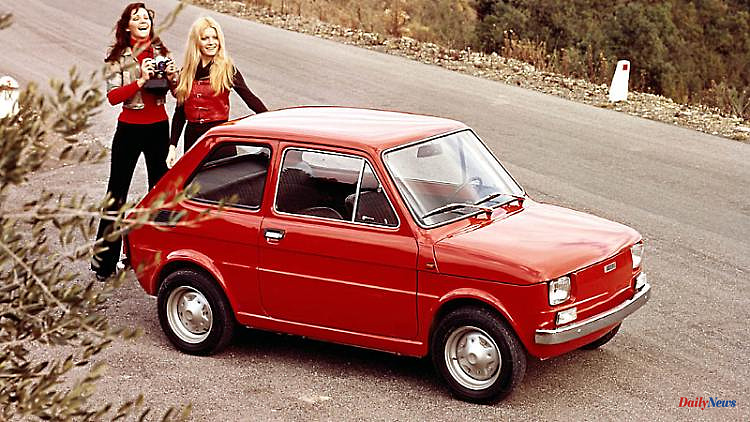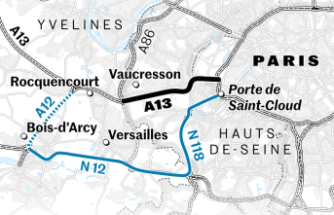Fiat understands better than many others how to turn the smallest cars into great cult vehicles, as the cute and charming Nuova 500 from 1957 demonstrated. Could there still be an increase? The Fiat 126 that followed in 1972 sold even more successfully as the king of miserly money and a tiny family runabout.
Today it is the 9-euro ticket for local transport that is causing a sensation, but the older ones will remember: city transport was almost free 50 years ago and this with a four-seater car. The name of the star designer was Fiat 126 Gian Paolo Boano designed speedsters for the hustle and bustle of the big cities, and this two-cylinder type drove four people at a price of five pfennigs per kilometer, as Fiat and the specialist media unanimously reported enthusiastically.
Back then, nobody was cheaper, not even a Citroen 2 CV or a VW 1200 - and neither were buses and trains. But that's not the only reason why the last Italian rear-engine Mini, for the time being, wrote a sensational success story. At nearly five million units, the Fiat 126 outsold its legendary predecessor, the cute Fiat Nuova 500. As Fiat's chief designer Dante Giacosa confessed in his memoirs, the development of the successor to the Nuova 500, Italy's national monument of the year 1957, his greatest challenge. However, Giacosa, who put the Topolino on the wheels as early as 1935, only supported the Fiat 126 project as a consultant for reasons of age, but this was successful.
As affordable as a spaghetti meal, with an optional folding roof for that dolce vita feeling under the southern sun and painted in bright colors like the laundry over the old town streets of Naples, the tiny Fiat 126 won the sympathy of the public even more than its predecessors global city car community.
It was not without reason that the small two-cylinder dwarf was built almost unchanged for almost 30 years and sold almost five million units during this time, Fiat proudly announced in 2000. At that time, the final example of the small people's runabout was produced in Poland as a special model "Happy End" and transferred to the Fiat Museum in Turin. The Fiat 126 thus surpassed the sales volume of the Nuova 500 and even outlived its designated successor, the Cinquecento launched in 1991.
The Fiat 126, with its clear edges, was never able to match the legend of the Nuova 500's kissable shape, which was revitalized in 2007 in the retro design of a technically modern 500. Nevertheless, the relationship between the Fiat 126 fans and their minimalist vehicle (at 3.05 meters in length as short as the British Mini, but at 1.37 meters much narrower) was intimate, as was the multitude of nicknames or even official nicknames indicates.
In Italy, a van version of the Fiat 126 was advertised as Bombel ("small child"), and in Germany, over 85,000 Fiat customers responded to the importer's call for a name for the better-equipped Fiat 126, which then mutated into the 126 Bambino. From 1975, Europe's smallest four-seater developed into the first automotive giant to break new production records in Eastern Europe - in that year the career of the Fiat Nuova 500, which was built at the same time for a short time, ended - in Poland.
The "Fabryka Samochodów Małolitrażowych" (FSM) built these tots in the Bielsko-Biala and Tychy works, which the vernacular called "Maluch" ("dwarf", "little one"). From 1997 even a "Maluch" signet adorned the rear of this early Polish people's car, which differed from the Italian original mainly in the type code 126p and a more robust, higher chassis design.
The production of the Maluch turned out to be so profitable that the production in Italy was stopped prematurely and in the end all Fiat 126 were "made in Poland by FSM". The FSM-Fiat conquered the whole world, in various countries of Eastern Europe they were sold as "little Poles", in Cuba as "Polaquito" and in Australia as "Niki".
Cavaletta, on the other hand, was the name of an Italian beach car based on the Fiat 126, which, to the disappointment of many beach car fans, was not mass-produced. When production of the Fiat began at Zastava in Yugoslavia, buyers thought they recognized the sober 126 as a tiny iron, a "Peglica". The Slovenes, in turn, delighted in the nimble flea "Bolha".
The Austrians were also able to come up with a specialty, the Steyr-Puch 126. The Alpine engine and all-wheel drive specialist Steyr-Puch gave the 126 the engine of the Haflinger off-road vehicle, including an increase in output to 18 kW/25 hp. With a top speed of 117 km/h, the 18 kW/25 hp Steyr-Puch were 12 km/h faster than the 126 Fiat - and were suddenly able to shoo the Mini 850 and even almost the VW 1200.
In complete contrast to the Fiat 126 of German provenance, which was equipped by the Steinwinter company with 250 cc two-stroke engines from the Goggomobil, which died out in 1969. These 126s, called "Figo" (Fiat Goggo), were aimed at holders of the previously issued Class IV driving licence on the car: at times more than 30,000 Fiats were sold per year in the Middle Kingdom, with the dwarf surprisingly often being used as a taxi.
After all, Fiat had always emphasized the four-seater qualities of the 126: "Four upholstered, full-view seats with adjustable front rests," said the prospectus back in 1972. From 1976 the Fiat 126 Personal 4 - called Bambino in Germany - had more elaborate rear seats with velvet or synthetic leather, plus bumpers and protective body strips made of plastic.
Lifestyle flair was conveyed by candy-colored paintwork such as orange-red, Tyrolean green or butterfly blue, and from 1978 also the 126 special editions "Silver", "Red", "Black" or "Brown" with fine decorative stripes and tinted windows. Two years later, however, the inexpensive Fiat Panda with front-wheel drive made its debut and now competed with the Fiat 126 for the status of king of minimalists. Reason for the creative Fiat engineers to immerse the veteran 126 in a fountain of youth.
The 126 BIS came out in 1987 with a practical tailgate and folding rear seats. A horizontally installed, water-cooled engine created space for the additional luggage space under the large hatch. The ingenious, now very old Dante Giacosa was pleased that his last "child" still offered potential for evolution. However, production of the 126 BIS was discontinued just four years later because the modernized two-cylinder engine tended to overheat. In addition, the groundbreaking modern Cinquecento, launched in 1991, finally made the 126 BIS obsolete in Western Europe.
Not so in the rest of the Fiat small car cosmos. The production of the Polish Maluch in the proven body shape continued. After a final facelift with parts from the Cinquecento, the Fiat traded under the code 126 EL from 1994, and three years later the Poles gave it a regulated three-way catalytic converter. No wonder that the memory of number 126 in Eastern Europe is particularly vivid to this day.












